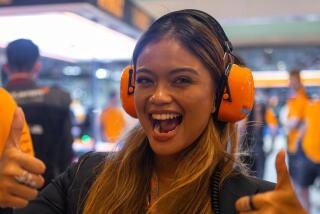Shauna Rohbock hopes to be fastest woman in a bobsled
- Share via
Reporting from Whistler, Canada — Shauna Rohbock prefers her martini shaken, not stirred.
The bobsled driver of USA-1, who won silver in 2006, hopes to be the fastest woman on the fastest track when the two-day competition begins Tuesday.
But perhaps the biggest obstacle in her icy path is Germany’s Cathleen Martini, a two-time world championship silver medalist who won five of the eight World Cup races this season.
“She’s been strong all year,” said Rohbock of her rival. “She gets a good push and drives it from there. She doesn’t need much motivation to kick it in gear.”
Coming up with her own powerful engine took some trial and error for Rohbock, who lost 2006 brakeman Valerie Fleming to injury. She tried three pushers over the course of the season before settling on Michelle Rzepka, who provided the oomph in their two World Cup victories.
“She’s pretty hard on herself and very driven,” Rzepka said. “She thinks outside the box. I trust her, though. She’s very serious. At the top on the start deck, she’s calm and ready to do her thing. She has a killer instinct.”
Rohbock agrees.
“Sometimes I say to myself, ‘Oh, I don’t really care,’ but I get to the bottom and I’m so mad at what happened,” she said. “I hate to lose. And you see some people on that podium and you’re like, ‘They should not be there. I should have beaten them. That was a stupid run.’ ”
In addition to Martini, there are other forces to be reckoned with.
Germany’s Sandra Kiriasis, the returning gold medalist, stayed in the top of the pack all season to win the overall World Cup title. Kiriasis beat Rohbock in 2006 by 0.71 of a second over four runs, but since then has changed brakeman and isn’t as explosive.
If it’s experience that makes the difference, the Canadians should have it on their home track. But with the exception in skeleton, where Jon Montgomery took gold, that hasn’t played out. Still, pilots Kaillie Humphries and Helen Upperton finished the 2009-2010 season ranked second and fifth, respectively, and Humphries earned the silver medal at the test event in Whistler.
The track has been kind to the three American drivers as well. At the World Cup, Rohbock earned gold, USA-2 driver Erin Pac -- with Rzepka behind her -- took bronze, while USA-3’s Bree Schaaf finished sixth.
Inevitably, talk turns to track safety. Over the last four days, the international federation allowed more practice runs “out of an abundance of caution” following the death of Nodar Kumaritashvili in Curve 16 during a training run hours before the start of the Olympics.
That has quieted nerves, but only a little.
“All the alarms are going through your head,” Schaaf said. “It’s like ‘Mayday, mayday, mayday,’ but the maydays don’t stop until [Curve] 16.”
Unlike a two-run World Cup, Olympic competition is spread over two days, giving drivers time to ponder their mistakes.
Rohbock faced that situation after the first day in Turin, when she was in third place, 0.1 of a second away from silver and 0.9 away from gold. Sleep, she said, was harder after she won silver.
With eight years of driving under her belt, Rohbock said she feels more prepared. Still, she marvels at the institutional memory of the German drivers, especially Kiriasis, who has been on her national team for 10 years.
“The more and more you drive, you learn the little things,” she said. “That’s what she has on me. She understands the little things that give her that .10 of a second. I would love to have that knowledge.”
candy.thomson @baltsun.com
More to Read
Go beyond the scoreboard
Get the latest on L.A.'s teams in the daily Sports Report newsletter.
You may occasionally receive promotional content from the Los Angeles Times.





